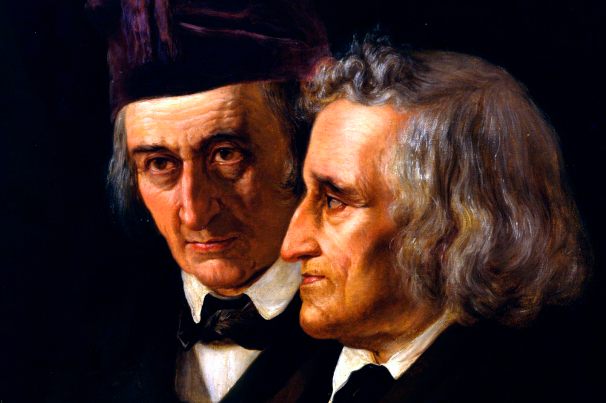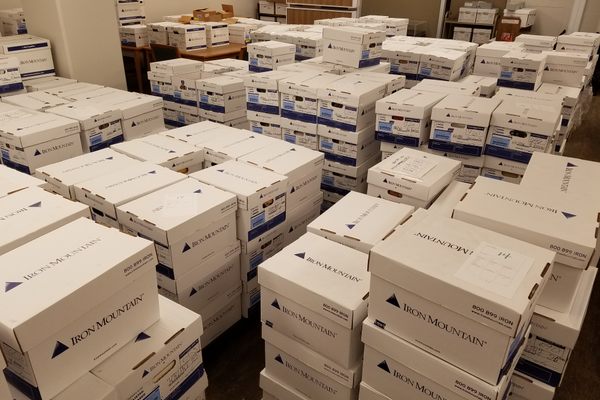The Grimm Brothers’ Other Great Project Was Writing a Giant German Dictionary
They got up to F, and then it took another century to complete.

In 1837, Jacob and Wilhelm Grimm, the brothers most well known for their eponymous collection of fairy tales, were kicked out of their home. They had been working as professors at the famous University of Göttingen, Germany, when the King of Hanover, who ruled the area, demanded they and other academics swear an oath of loyalty.
The Grimms, along with five other professors, refused. The “Göttingen Seven” were stripped of their posts, and three of them, including Jacob Grimm, were banished from the state. He and his brother retreated to their hometown, Kassel. All of a sudden, the Brothers Grimm needed a new source of income.
They decided to take up an offer they had previously refused, from a publisher based in Frankfurt. They were to create a dictionary of the German language, a project so massive that by the time Jacob and Wilhelm died (in 1863 and 1859, respectively), they had only completed up through E. When the Deutsches Wörterbuch (The German Dictionary) was finally finished, more than a century later, it became the largest German dictionary ever compiled.

Though the project promised to be massive, the Grimms originally expected the job could be accomplished with four volumes. Even as that number began to expand, Jacob estimated it would take about 10 years to complete what had become a total of seven volumes. They planned to use German literature, from Luther to Goethe, from the 16th to the 18th centuries, to identify the words that should be included.
Quickly, though, the project sprawled in both time and space. The Grimms hired readers to comb through key texts, document word use, cite relevant quotations, and submit words cards for inclusion in dictionary. That work was supposed to take a couple of years, until 1839. Instead the brothers were receiving word submissions through the 1840s, as Kelly Kistner, who studied the dictionary as part of her doctoral work at the University of Washington, writes. The process of alphabetizing the submitted words didn’t begin until 1847.

In the early 1850s, more than a decade after they started the project, the Grimms began to release the first results. The first full volume of the dictionary wasn’t published until 1854, though, and it only included A to Biermolke. (“Biermolke” translates to “beer whey,” or, as the Grimms put it, “whey of such milk as can be coagulated into beer.”) The second volume, Biermolke to E, appeared six years later, in 1860, the year after Wilhelm died. (He had only completed the Ds.) Jacob died three years later, in 1863, still in the middle of the Fs. The last word he worked on was “Frucht,” “fruit.”

The entries that the Grimms created did not necessarily conform to the standards we have for dictionaries today. At the time, the idea of systematizing a language in a comprehensive reference book, with etymologies, historical uses, and references for each word, was an innovation. The Oxford English Dictionary would not be published for another two decades, with its first edition in 1884. So the Grimms made up the rules for the project as they went along. They considered their dictionary a sort of natural history of words, and their entries weren’t beholden to offering clear definitions. Jacob, in particular, presented personal musings on the development and history of intriguing words. The result was sometimes poignant and beautiful—but not exactly standardized.
Still, after the brothers’ deaths, their colleagues believed the project was so important that it needed to be finished. In 1867, the project started to get government funding, and for years the Grimms’ successors toiled, ever so slowly. Rudolf Hildebrand, who started as a proofreader and later became an editor, estimated in 1865 that the dictionary would stretch to 14 or 15 volumes. In his own work on the dictionary, which was supposed to start with K, he only managed to finish K and part of G.
In the early 20th century, the Prussian Academy of Sciences took over management of the project and work on it continued through World War I. During World War II, the staff of the dictionary dwindled to just three, and like other valuable cultural objects the records of the work were stored in salt mines, where they were discovered by Russian troops and eventually brought to Berlin. After the war, work on the dictionary was recast as an East-West collaboration, with work split between Göttingen and Berlin.

In 1951, about a century after the first slim section of the dictionary was published, Ralph A. Brenninger, writing in The German Quarterly, reported that the finished product was likely to be 32 volumes in all. He turned out to be correct. When finally completed in 1961, the dictionary contained 330,000 headwords in 32 volumes. By the time it was published, though, there was already a plan to rework the original A to F volumes, which, written in the Grimms’ meandering style, didn’t stand up to modern scholarship.
There was also an ideological critique of the Grimms’ dictionary work. Even when the first volumes were released, some reviewers thought the words included had a bias—too much Luther, Kistner reports. But by the 1960s, the Grimms’ efforts had come under suspicion as a nationalist project that had fed into Nazism. In part, this critique was inspired by the brothers’ own fervent patriotism—Jacob often wrote of the need of a standardized language to unite the fatherland—and the Nazis’ later adoption of the Grimms’ work for their own purposes. (They required schools to teach the fairy tales.) By the 1960s, the brothers’ work on the dictionary work was dismissed as a dangerous ideological project.

Kistner argues, though, that these critics misunderstand the Grimms. The dictionary should be understood as a project riddled with Romanticism, which saw an organic unity to language, part of “a self-organizing world in constant motion, of autonomous but interdependent agents,” rather than a body of data that could be pinned down definitely. “It is likely that [Jacob] Grimm honestly believed that his dictionary selections, while not perfect, were not truly arbitrary,” Kistner writes, “rather, that they followed from his perceived organic unity of the language.” In other words, the dictionary was meant to explore the living landscape of the language, rather than preserve dried specimens of words.
The effort to rewrite A to F went on for decades—the revisions were only finished in 2016. Close to two centuries after it was first conceived, the Deutsches Wörterbuch, started as an effort to pay the rent, is a monument to the German language—and the legacy of the Brothers Grimm.





























Follow us on Twitter to get the latest on the world's hidden wonders.
Like us on Facebook to get the latest on the world's hidden wonders.
Follow us on Twitter Like us on Facebook